 Crop & Field Notes: In the thick of it!
Crop & Field Notes: In the thick of it!

Breen Lettuce Seedlings
Overwhelmed with the amount of harvesting going on at the moment, it’s always tricky to stay on top of propagation and planting schedules. Most of our crops are raised from seed, grown into seedlings and hand transplanted when they are large enough to thrive under the more challenging field conditions.

Red Russian Kale Seedlings
The moment a seed is sown, the clock starts ticking. Field preparations need to be timed so as to overlap with the maturity of the seedlings, which then need to be planted on a specific schedule. August through September is always a critical time to plan ahead for Fall and Winter crops such as Parsnips, Rutabaga, Romanesco Cauliflower, Celery Root, and of course more broccoli, lettuce, carrots, beets and leeks. We even try to squeeze in a late planting of summer squash and green beans. Sometimes I envy my fellow farmers in colder climates where hard frost and snow will call an end to the outdoor growing season. Here, with our relatively mild weather, we grow crops year-round.

Little Gem Lettuce Seedlings
The Apple harvest starts this week. First up are our crunchy Summerfelds, a variety discovered in a Central Valley Orchard as a chance seedling and believed to be a cross between a Gala and a Fuji. It is a fairly large sweet apple with firm, crisp, juicy flesh. Well balanced, sweet, similar to a Fuji it’s great for baking, as a snack, or cut into a salad. Extra Fruit shares will get the first ones this week.
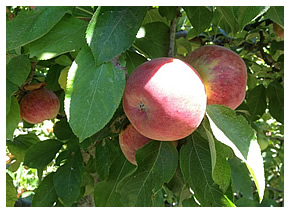
Summerfeld (or Sommerfeld) apples
Apples are ripening, school is starting, and it’s time to think about preserving some of this summer’s bounty. This Saturday we invite you to the farm to pick your own dry-farmed tomatoes (click here for details), and other crops you will discover are abundant and ripe for picking. (i.e. raspberries, cherry tomatoes, peppers…)
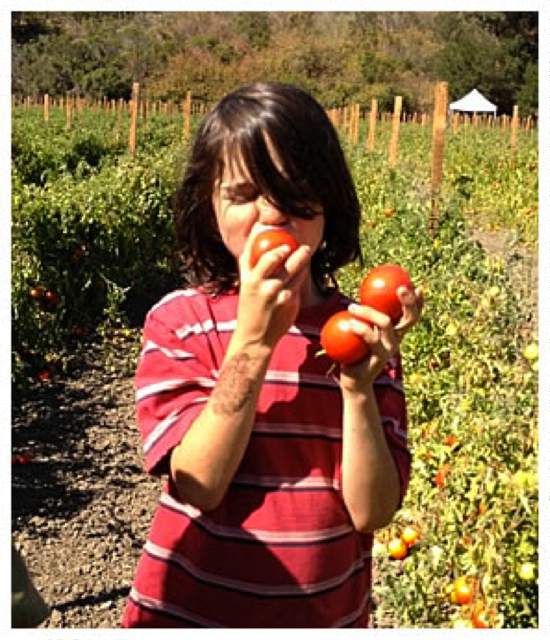
Picking and eating something right from the field where it is grown is deeply satisfying. It speaks to the farmer within us, the one that believes in growing flavorful, fresh, and nourishing food. It speaks to the cook in us who enjoys preparing a delicious meal, and of course it speaks to us all who enjoy eating and sharing a delicious wholesome meal.

Winterbor Kale Seedlings
The guiding principle of our farm is to maintain that intimacy between farm and community, such that we can all experience the pleasure of this nourishing relationship.

Recently transplanted broccoli seedlings.

Trout Lettuce Seedlings

Amadeus Broccoli Seedlings

Ruby Lettuce Seedlings

Toscano (Dino) Kale Seedlings. The ones in the foreground were planted on Aug 6th while the ones in the background were planted July 30th.
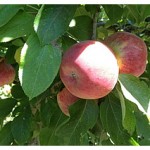 Crop & Field Notes: Dry-farmed Tomatoes, Apples, and Strawberries
Crop & Field Notes: Dry-farmed Tomatoes, Apples, and Strawberries
The waiting is over; dry-farmed tomatoes will be in everyone’s share this week. What’s special about dry-farming? First, it doesn’t use much water but more importantly it brings the best flavor out of a tomato. Dry-farming tomatoes is a technique perfected a couple of decades ago by Molino Creek, a farming cooperative situated in the coastal hills above Davenport. We are fortunate to enjoy a similar microclimate. Dry-farming techniques involve proper spacing, soil moisture control, timely cultivation practices, soil rotation and a number of different fertility practices. Under optimum conditions the plants, although stressed from a lack of water, will stay healthy enough to yield tomatoes bursting with flavor.
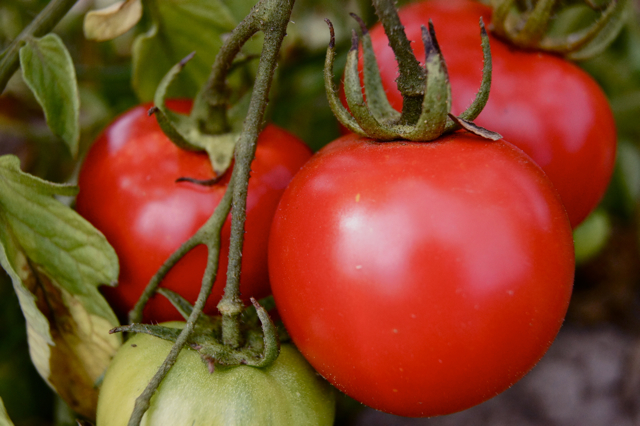
“Early Girl” is the variety of choice for dry-farming; it is one of the very few tomato varieties (possibly the only one) that can be dry-farmed. Although this popular tomato variety was bred in France, tomatoes find their origin in the impenetrable jungles of Central and South America. The Mayans called it “xtomatl” hence the name tomato. When the Spanish brought the first tomato to Europe the Church condemned eating tomatoes as a scandalous and sinful indulgence. The French on the other hand admired its sensuous appearance and were enticed by it, believing that the red fruit had aphrodisiac powers, and so called it “pomme d’amour” or love apple. Today, we probably couldn’t imagine anything more scandalous than not having tomatoes as part of our diet.
The crop of tomatoes we are now harvesting was sown in a greenhouse in mid-January and transplanted in the field in March. It takes over 6 months from planting the seed to finally harvesting the first tomatoes. To extend our harvest into the fall, we add two additional tomato plantings staggered 3 and 6 weeks apart.
Besides “love apples” we are starting to harvest our true apples. The first, the Summerfeld, might make it into our fruitshares this week to replace the strawberries, which are going through their natural seasonal downcycle.

Summerfeld apples
 A Farmer’s Pleasures
A Farmer’s Pleasures
It’s a dance – I check on crops daily, sometimes even more often, to assess both quality and quantity to project and spread the harvest for our weekly commitments to the CSA, farmer’s markets, and wholesale accounts. A field-walk of course involves a lot of sampling, and right now there is a lot to snack on.

The fruit are always tempting and the cane berries, i.e. blackberries and raspberries, are irresistible. My hand can’t be stopped when a shiny blackberry or red raspberry is hanging eyelevel, ready for “the picking”.
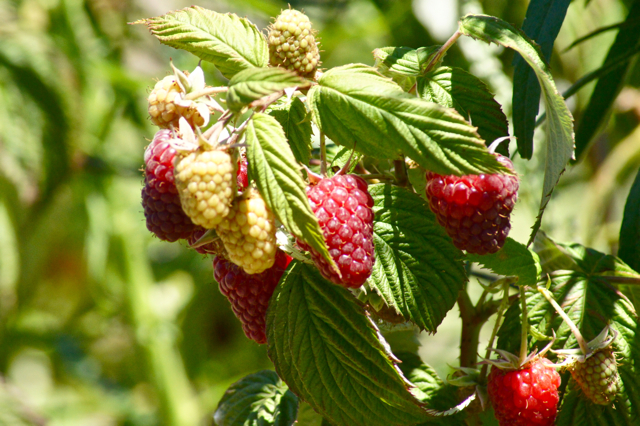
The same goes for the cherry tomatoes, the plums, the apples (just tasted the first Pink Pearl and Mc Intosh off of our recently grafted trees).

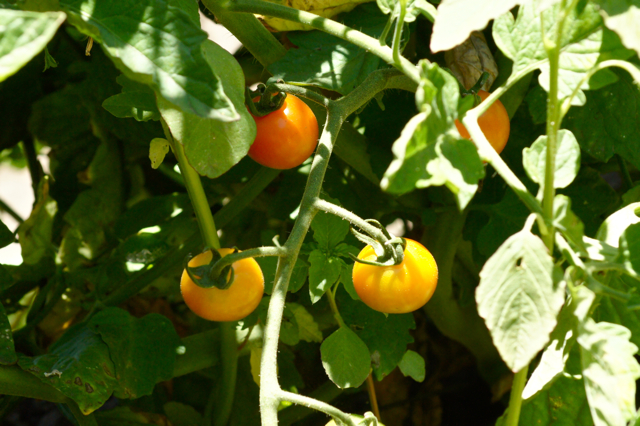
The red spots among the lush green pepper plants, invite me to bite into a ‘Corno de Toro’ or ‘Round of Hungary. ’ Their crunchy, flavor packed, slightly sweet thick flesh is a real treat. They are the next peppers you’ll be getting in the boxes.
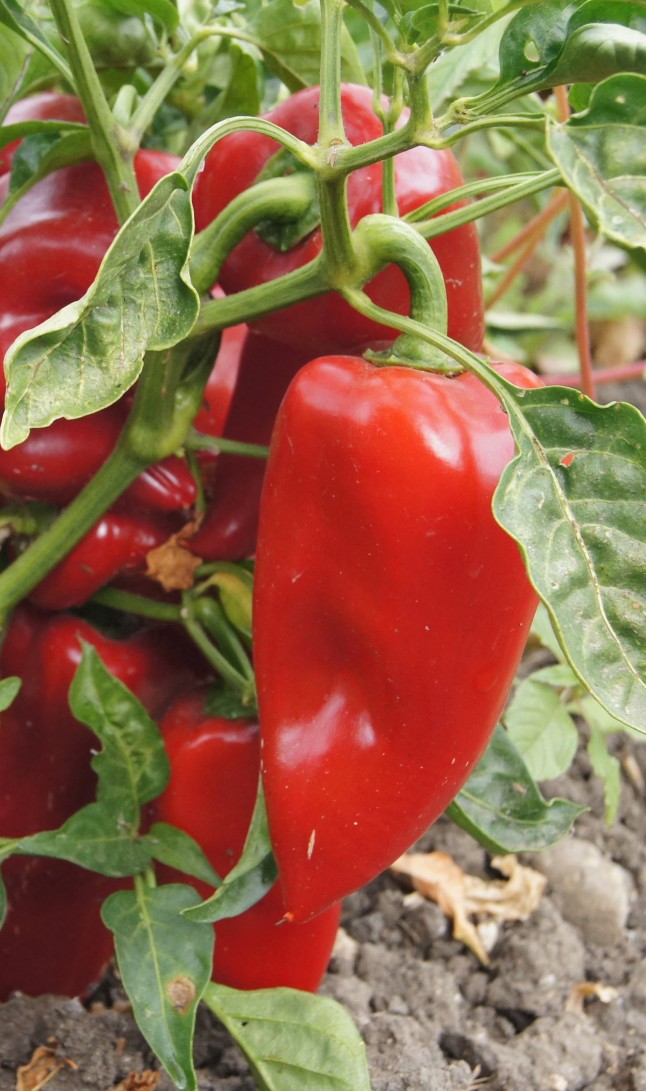
Roasted, fresh, sauted, in soups, pickled, you name it, there are so many ways to cook with these exquisite heirlooms. Who says we can’t all be cooks? Just let your senses – your eyes, smell, taste, touch – be your guide.

I can’t help myself but I have to always dig, and when I am next to a carrot or radish patch I like to look for these treasures. Snacking on a freshly pulled carrot or radish is never disappointing.

At this time of year a field-walk will leave me stuffed with no need to go home to prepare lunch. And no matter how much I have field snacked, there is always room for another juicy strawberry!!

Plants will often stop me in my tracks. While rushing from one thing to the next I had to stop and admire the stand of sunflowers on the edge of one of our fields between the apple orchard and the cherry tomatoes. Started as small seeds in the greenhouse during the cool days of April they are now towering over my head.
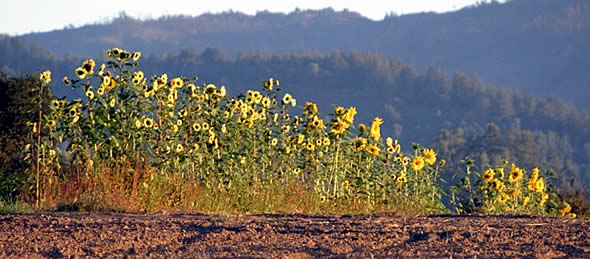
As I contemplate the beauty of a radiant giant sunflower with a honeybee heavy with pollen resting on it, I am reminded that in nature we are constantly surrounded by beauty, and it just takes a little slowing down to be touched by it.
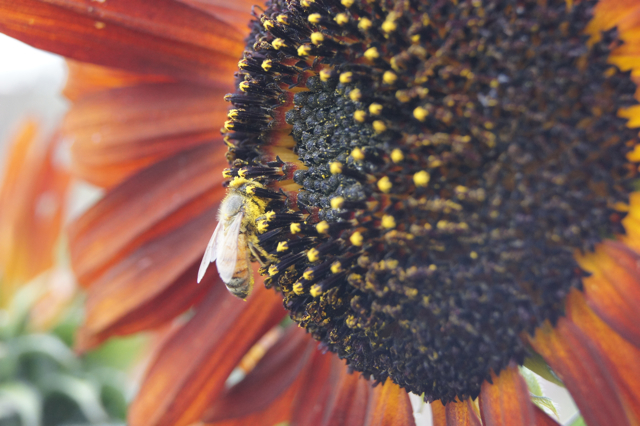
 Dancing with the Crops – It’s all about timing
Dancing with the Crops – It’s all about timing
Last Friday the “Food What” team (see last week’s post) gave us a hand harvesting potatoes, a mix of Yellow Finns, Red Pontiac and Fingerlings. Since we don’t grow enough potatoes to justify investing in a potato harvester we first use a large tractor mounted plow shovel which loosens the soil and lifts the majority of the potatoes to the surface inside a freshly dug furrow.

The teens formed groups (4-5 to a furrow) collecting potatoes into buckets first and then emptying them into apple bins. With the help of a front-loader the bins, once full, were lifted into our truck and hauled into dry storage. Again, an impressive effort by the “Food What” team: 7 bins, approximately 6000lbs of potatoes got harvested.

While combing through the soil on our hands and knees picking up potatoes, Edgar, one of the youth, was curious how we were able to grow so many crops and do so year-round. Edgar’s question is at the heart of what is probably one of the more challenging juggles on our farm – succession planting. If we time our cropping cycles just right we can maintain continuity and abundance throughout the year. Right now when so many crops are maturing at the same time, it is easy to get distracted just trying to stay on top of our harvests and fall behind on sowing and planting schedules for crops needed for November-December when days are shorter and colder.
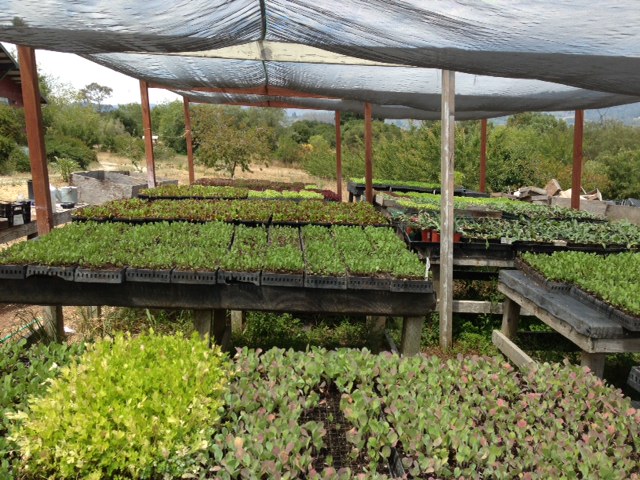
The green house right now is filled with trays growing seedlings of Brussels Sprouts, Romanesco Cauliflower, Celeriac, Winter leeks, Collard Greens, as well as late season successions of cucumbers and summer squash. Of course we need to continue to stay on top of our plantings of lettuce, kale, and broccoli, as well as field sown crops such as carrots, beets, parsnips, spinach, radishes, and late season green beans. It never really ends!
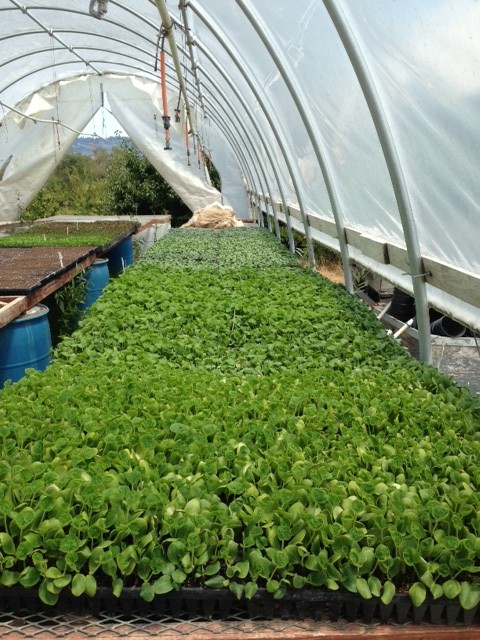
Each crop has its unique rhythm and life cycle, and its own particular character. Radishes and most leafy greens are fast and short lived; carrots and beets are steady and reliable; lush crucifers such as broccoli, cabbage and cauliflower like it cool and are generally hungry and thirsty.
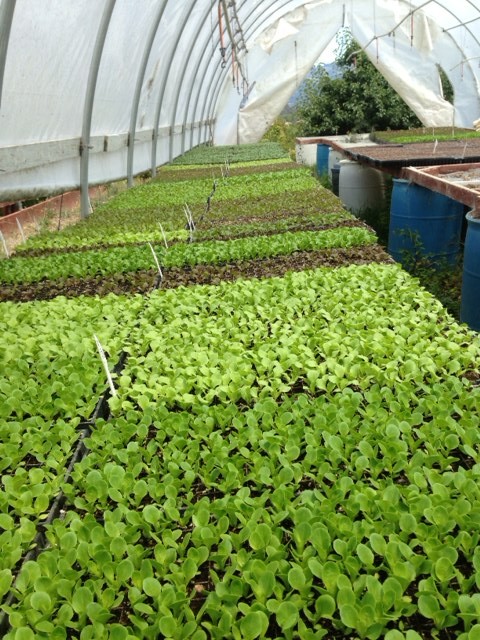
Successional plantings not only need to fit natural variables such as soil moisture, temperature, and day length, but also need to synchronize with the timing, field rotations and the unique physiological and cultural growing habits of all the other crops. Succession Planting is the Farm’s version of dancing to mother nature’s seasonality. It’s all about timing and will seem effortless if every part of the farm, whether biological, mechanical, meteorological, or human, harmonizes. Most of the time we are all pretty clumsy dancers, but to experience just a moment of perfect harmony, makes it all worthwhile.
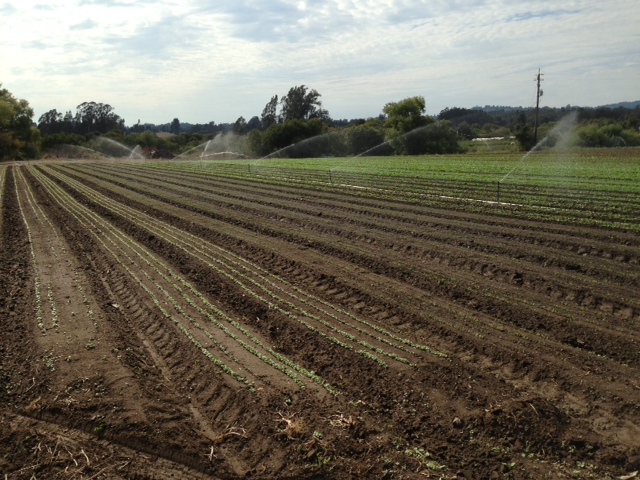
In this picture you can see how crops are planted in succession, with the more mature crops on the right.
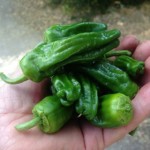 The Padrones are back – and other goodies soon to follow!
The Padrones are back – and other goodies soon to follow!
When my family had this season’s first roasted Padron Peppers a couple of weeks ago, the kitchen filled with that familiar, tantalizing aroma and everyone came to the table with a smile to enjoy their irresistible taste and sometimes unpredictable biting spiciness. The Pimento (Chile) de Padron, or Padron Pepper, roasted, then sprinkled with olive oil and coarse salt, has many of us hooked; even our 8-year-old Elisa will help us finish a large plateful at dinner. If you are unfamiliar with these green peppers, make sure to look up our recipe database for a description of ways to prepare and enjoy them.

Padrones – fresh and roasted.
Padron Peppers are said to have been brought to Spain from Mexico by Franciscan monks in the 16th century, where they were then adapted to the soils and climate of Galicia near the town of Padron, after which the peppers are named. The town of Padron is located near the Atlantic coast, where today the peppers are grown extensively in a climate probably very similar to ours. The people of Padron best describe the character of these peppers in their native Galician as “Os pementos de Padron, uns pican e outros non.” (Padron peppers, some are hot and some are not.) Indeed, eating Padrones is likened to playing Russian Roulette — you never know which one you bite into will be burning hot. So enjoy, but don’t forget to have something close by to cool your palate should you encounter a hot one!

The first Green Beans of the season are sizing up nicely and will be in shares next week. Santa Rosa Plums will be in the fruit shares and the “toe curling” sungold cherry tomatoes are only a couple of weeks away. Sweet Peppers are starting to take on some color, we will be harvesting and thinning some of the heavily weighted plants and putting them in the shares. Baby Carrots will be back again next week. Enjoy!
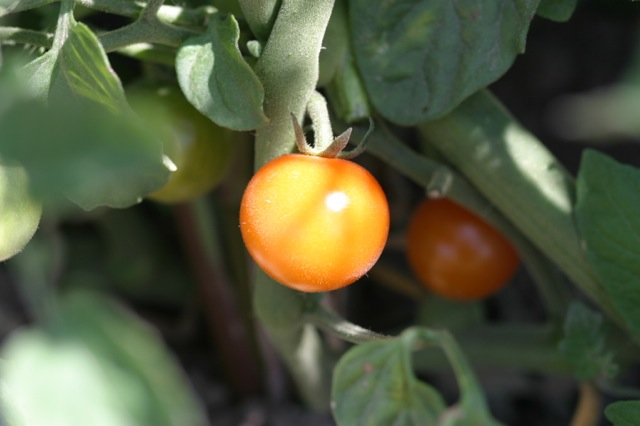
 CSA Members Only Apricot U-Harvest
CSA Members Only Apricot U-Harvest
Saturday, June 29th
10:00AM – 3:00PM
CSA Members ONLY
Apricot U-Harvest
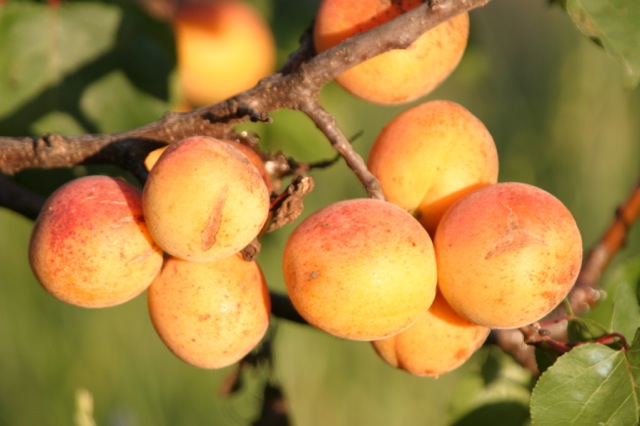
Apricots are here, and ripening fast. The next 2-3 weeks the Blenheims will be our focus of attention. It’s important to not fall behind since the ripe fruit tends to drop to the ground. Every share and extra fruit option will receive a portion of this year’s bounty
This may not be enough however for many of you who would like to enjoy them in larger quantities, especially if you like to preserve them. To accommodate our CSA members’ cravings, we decided to hold a CSA MEMBERS ONLY Apricot U-Harvest, this Saturday on June 29th. (CSA members may bring friends.)
The farm will be open between 10:00AM and 3:00PM. We encourage you to bring your own bags and containers (our boxes cost $1.50 each). This year’s price is $2.00/pound, and we may have a harvest limit of 30-40lbs per family. It depends how ripe and abundant the fruit are.
Please use the Litchfield Lane entrance to the farm. If you don’t mind walking up a steep hill, you can also use the second entrance on Green Valley Rd and park by the main barn. You are welcome to explore the farm, bring your own food and find that perfect picnic spot.
Click here for directions to the farm
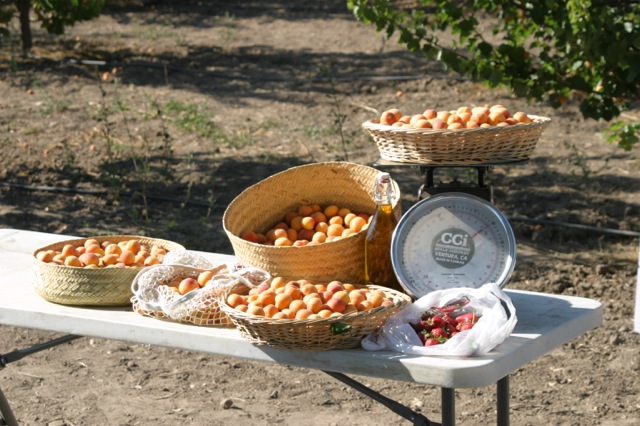
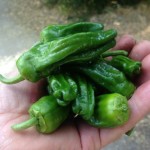 Turning of the Season: The Summer Harvest is Starting
Turning of the Season: The Summer Harvest is Starting
The apricot crop is at the verge of being ripe, and I enjoy walking the orchards and sampling the fruit to assess when to start the harvest.
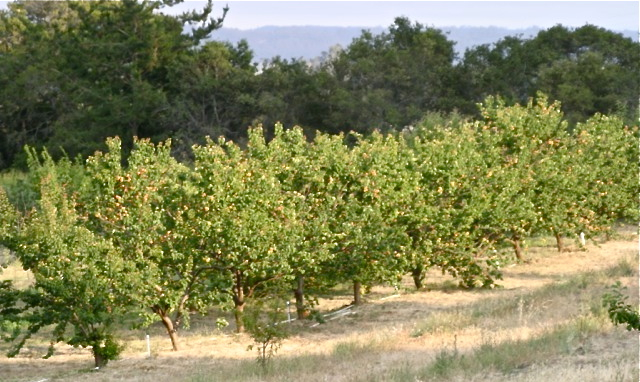
Ridge top Apricot orchard
There are three apricot orchards on the farm, each maturing at slightly different rates due to their different exposures in the landscape, one facing east, another northwest, and the third one growing on more level ground on top of a ridge. This difference in exposure helps stagger the harvest workload. Right now, the orange color of the apricots is deceiving since the majority is still crunchy and hard. I am waiting for another week when the fruit are a little softer, expressing their wonderful flavor and sweetness.
A crop close to maturity has a unique allure. I delight in being the first to taste and savor a ripe fruit directly from a plant. Picking a juicy soft sweet apricot with that perfect pitch of ripeness is a real treat. As we are about to turn the seasonal corner into summer I recognize this familiar eagerness, almost impatience welling up in me to harvest the next round of crops.

Santa Rosa Plums
The Santa Rosa Plums are starting to turn red-purple in color, but even the darkest ones are too sour and make my mouth pucker when I bite into one; they are probably 2 weeks away from harvest.
The Sweet Pepper harvest has started with some early Yellow Hungarians going into the family shares this week. Also, the popular Padron Peppers will be harvested this week, most likely some finding their way into our extra fruit options first and soon all other shares in the weeks following.
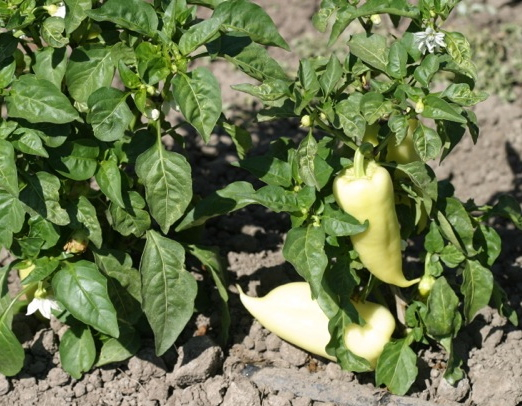
Yellow Hungarian Sweet Peppers
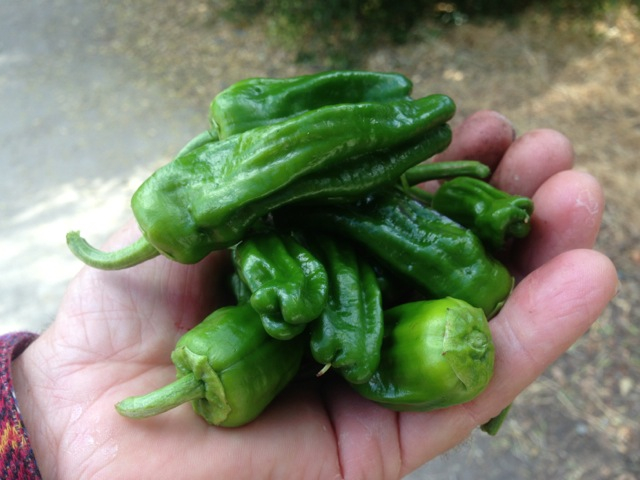
First Padrons of the Season
The rest of the peppers such as the Pimentos and Corno di Torros are still developing, and won’t have their full flavor until showing some yellow or red colors, probably sometime in July.
Right now, of course, no field walk is finished before checking on the tomatoes, which have plenty of green fruit and flowers.

Green Dry-farmed Tomatoes
Our Sungold Cherry Tomatoes will be the first to mature. I already harvested a few early maturing clusters at the base of a plant, hidden among its lush green foliage.

Just ripened Sungold Cherry Tomatoes
As I watch in anticipation the flowering and fruiting crops, the rhythm of the season teaches me to be patient. As someone once said, “The fruit is green until it’s ripe, and you just can’t rush it.”
Friday marks the longest day of the year, the Summer Solstice, when the sunlight is at its peak in our hemisphere. Plants absorb, almost miraculously, this life nourishing light, manifesting the fertility of the earth. Just like the plants absorb the light that comes from the sun, we ourselves can recognize the fire within to grow and bring things to fruition. This Saturday, June 22nd we celebrate the Summer Solstice here on the farm and we invite you to join us.
Click here for the full schedule of events

Green Beans are also on their way
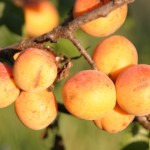 The Royal Blenheim Apricots are back!!
The Royal Blenheim Apricots are back!!

(Pencil in the possible pick-your own dates noted below. Active CSA members can soon order through our Web Store.)
I guess you can’t expect royalty on a “peasant farm” every year. After three years of no Royal Blenheim Apricot harvests, this year’s crop, due to dry spring weather, is abundant and about 2 weeks away from reaching maturity.
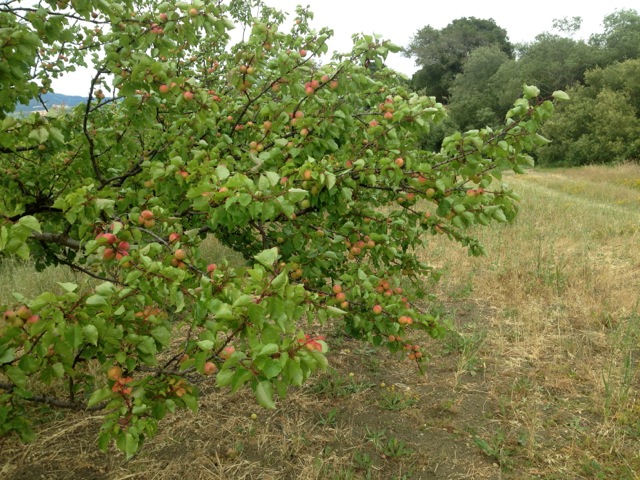
Royal Blenheim Apricots are irresistibly inviting in appearance and seductively aromatic and sweet. The Royal Blenheim, considered by many the best tasting Apricot in California, traces it’s heritage back to the Luxembourg Gardens in Paris and England’s Blenheim Palace. In the 1880’s this “noble” and delicate fruit was first planted in the gardens of the Spanish missions and expanded as trade with Europe came to a halt during the War years. The Blenheims were popular both for their high sugar content and superior sun drying qualities. In the 1920’s Blenheims blanketed Santa Clara and Alameda counties and the Sacramento Valley. Today only a few orchards of Royal Blenheims remain standing. Even fewer are managed organically and grown on a commercial scale in our cool and often moist coastal environment.

Blenheims have a short 2-3 week harvest period, typically lasts from end of June to mid July. The extra fruit options will have more than their value’s worth in Apricots, in addition to berries and plums. For anyone who would like to preserve these magnificent fruit for future enjoyment dried or as jams, we will sell additional 10lb boxes to active CSA members through the Web Store and deliver them with your share. For those eager to pick their own, I will tentatively pencil in June 29 and July 6th. We will announce a firm date in the next couple of weeks.
We are all very excited to once again offer our community this rare and amazing Apricot variety.
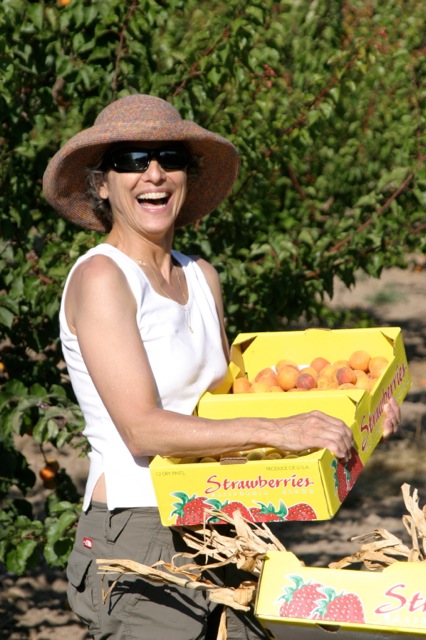
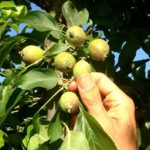 Snapshots of what’s happening in the field
Snapshots of what’s happening in the field
Between apple blossom and apple fruit, a tree is never left unattended and there is lots going on behind the scenes. After the enchanting springtime apple bloom it is now time to thin.

Thinning apples
Thinning an organic apple orchard is mostly done by hand, and takes a lot of time. Under ideal pollinating conditions each cluster will set five little fruits, of which all but one or two are pinched off to grow into marketable sized apples.

Thinning an apple cluster
Also, the thinning process gives us the opportunity to select for the strongest and healthiest of the developing apples in the cluster. For example, we can already thin out apples that have a little fungal scab, rosy apple aphid, or snail damage.

Thinned apples
Once the orchard is thinned it will be time to irrigate, which this year will need to happen soon since the trees haven’t gotten any decent rainfall since January. A month or two before harvest, in June or July, we will also do some selective summer pruning to allow sunlight to penetrate the trees to help color and improve the flavor of the apples.

Cherry tomato field
The short heatwave last weekend has the tomato plants developing quickly, many are starting to flower, which means we can’t fall behind on the important task of staking and trellising.

Flowering tomato

First trellesing strings
In the past, staking was a dreaded job as we used to pound every single stake by hand using a contraption built from a 2 inch metal pipe that has two large handles welded to it, jokingly this tool is referred to as “El Nino” or “The child”. Nothing cute or affectionate about it, but it requires the same movement as if one were to lift up a young child. The “Nino” once lifted up into the air is dropped on top of the stake several times until it is about a foot deep in the ground. It’s a tiring and time-consuming upper body workout we’d rather avoid. Ever since we purchased a tractor mounted hydraulic stake pounder two people can stake 5-6 acres in a few days, something that would take typically weeks. Now we don’t fall behind in the more important job of tying and trellising what are two of our most important crops – tomatoes and raspberries.

Staked dry-farmed tomato field
This year we were able to plant our potatoes early and the crop looks gorgeous, covering the entire field like a green lush blanket.

This season’s potato field
Soon the green will be offset by pretty white and purple flowers which means the plants are at a stage where they will have peaked in their growth of shoots and leaves and will start reverting that energy by directing it below ground to develop potato tubers. Digging around the base of the plants the other day, I could already find some small, egg-sized “treasures”. I estimate that in 3-4 weeks we’ll be digging our first red potatoes, followed by white and yellow and finally fingerling potatoes.

First of the Yellow Finn potatoes
 Crop & Field Notes: Beets are Back!
Crop & Field Notes: Beets are Back!

Chiogga Beets
Beets are back! Red Ace or the Sweet Chioggas, with their pink concentric rings, will be in your shares this week. Both have wonderful greens. To make the most of this often overlooked but amazing root, see Debbie’s Tips & Techniques for beets for a comprehensive overview of what your culinary options are.
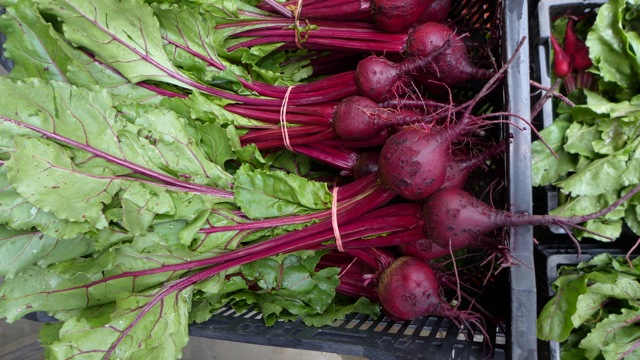
Red Ace Beets
The first summer squash is being harvested, most will go into the family shares next week.
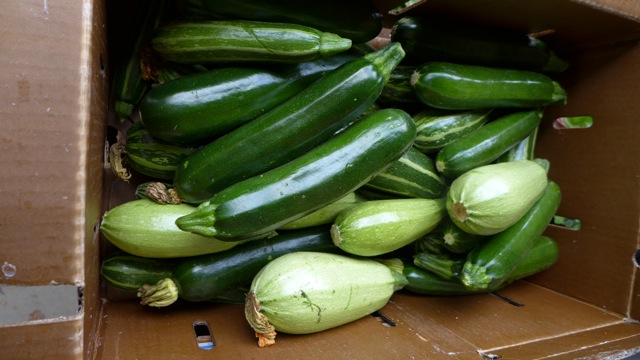
Summer Squash
Looking under the warming row cover I see beautiful healthy basil plants, next to peppers and cherry tomatoes.
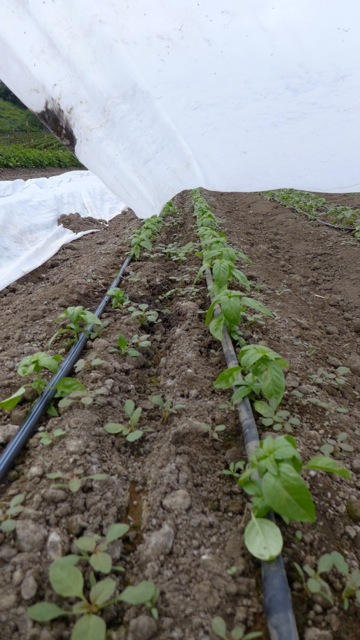
Basil seedlings under row cover
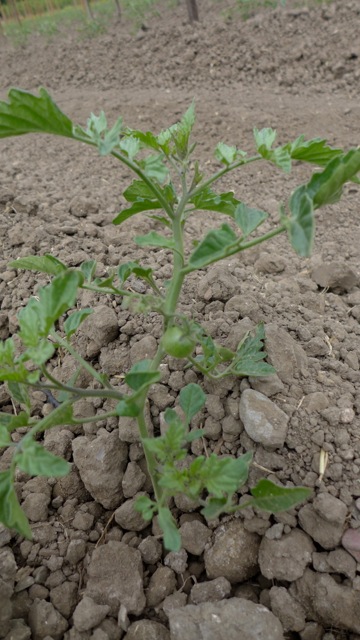
Cherry tomato with first fruit
In less than a month the blooming and fruiting caneberries (both blackberries and raspberries) will be ripe for picking.
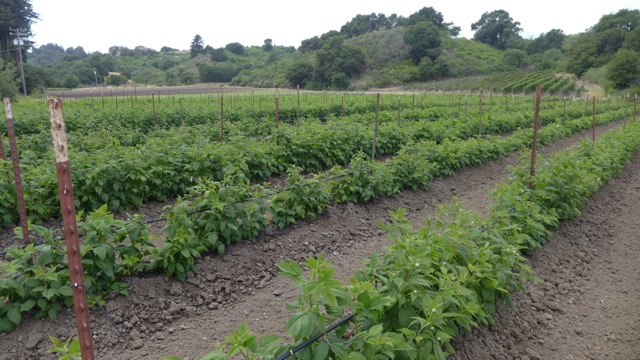
Raspberry plants in foreground; blackberry plants in the background

First, still green raspberries
Potatoes for everyone by the end of the month, available in your shares through most of the season.

Potatoes ready for harvest
